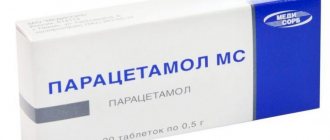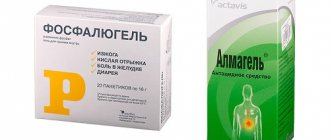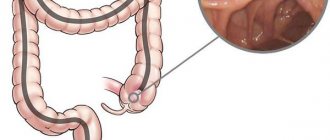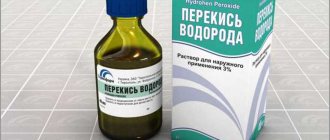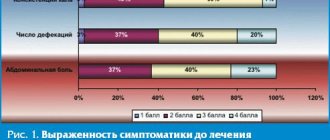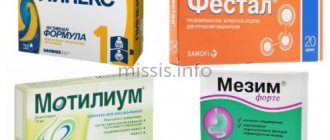Hydrochloric acid as an occupational hazard
S.'s aerosol in the air of the work area has a harmful effect; In addition, when working with S. it is necessary to take into account the possibility of the formation of other toxic compounds in the air, for example, arsenous hydrogen AsH3 (see Arsenic).
At high concentrations of hydrogen chloride in the air of industrial premises, irritation of the mucous membranes of the respiratory tract is noted with a runny nose, cough, even suffocation; blood may sometimes appear in the sputum; possible conjunctivitis, clouding of the cornea. Chron. exposure to S.'s aerosol can lead to the development of hypertrophic and atrophic rhinitis (see), sometimes with ulceration of the nasal mucosa up to perforation of the nasal septum, tracheitis (see), bronchitis (see), tooth decay, yellowish-kish . disorders; Inflammatory skin diseases are possible.
Aerosol S. to. causes severe pain in the skin of the face. Burns with hydrochloric acid are not as severe as burns with nitric acid (see) and sulfuric acid (see). Acute prof. poisoning caused by inhalation of S.'s aerosol is extremely rare. Wedge, the picture of acute poisoning with aerosol S. to. is characterized by cough, heavy rapid breathing; fine wheezing is heard in the lungs, sputum is coughed up with great difficulty, swelling of the larynx and vocal cords is possible; weakness, hot and dry skin, sallow in color, sharp pain in the stomach, frequent vomiting of yellowish mucus. When S. gets ingested, a wedge develops, a picture of poisoning (see): severe pain in the esophagus and stomach, hypersalivation, uncontrollable vomiting of dark masses containing necrotic elements of the gastric mucosa, motor agitation, convulsions, pallor or cyanosis of the face, pulse weak, frequent, arrhythmic; collapse is possible. Death occurs in the first hours and even minutes from shock or asphyxia due to swelling of the larynx, less often - after a few days from diffuse peritonitis, if there is a perforation of the stomach, or other complications (bronchopneumonia, nephrosonephritis, etc.).
Antacids
Antacids
(from Greek ἀντἰ- - against, Latin
acidus
- sour) - medications whose mechanism of action is based on the chemical neutralization of gastric acid.
Composition of antacids
The main acid-neutralizing active ingredients of modern antacids are magnesium, aluminum and calcium compounds.
Many of the modern antacid drugs, in addition, contain components that affect the gastrointestinal tract in a way other than neutralizing the acid: laxatives, carminatives, antispasmodics, anesthetics and others. Most modern antacid preparations use a balanced combination of magnesium compounds (magnesium oxide, magnesium hydroxide, magnesium peroxide, magnesium carbonate) and aluminum (aluminum hydroxide, aluminum phosphate and others). Such antacid drugs are characterized by a slower onset of therapeutic effect compared to sodium and calcium compounds, but they have a longer effect time. Such compounds do not dissolve in water, are practically not absorbed into the blood, are characterized by antipeptic properties and partially adsorb toxins. Aluminum compounds help slow intestinal motility and in large quantities can cause constipation, while magnesium compounds accelerate intestinal motility and have a laxative effect. Aluminum compounds enhance the synthesis of prostaglandins, promote the formation of a protective film on the surface of damaged tissues, adsorb bile acids and lysolecithin, and increase the tone of the lower esophageal sphincter. Magnesium compounds increase mucus formation and resistance of the gastric mucosa. The table below (Kharchenko N.V., Chernenko V.V.) shows the effects of the main components of modern antacid drugs (- no effect, + low activity, ++ medium activity, +++ high activity).
| Characteristics of some components of modern antacids | ||||
| Action/cations | Mg | Ca | Al | Bi |
| Neutralizing | +++ | + | ++/+++ | – |
| Adsorbent | + | + | +++ | + |
| Enveloping | – | – | + | – |
| Astringent | – | – | + | +++ |
| Cytoprotective | – | – | +++ | + |
Absorbable antacids
Absorbed antacids are those that either themselves or the products of their reaction with gastric acid dissolve in the blood. A positive quality of absorbed antacids is the rapid decrease in acidity after taking the medicine. Negative - short duration of action, acid rebound (increased secretion of hydrochloric acid after the end of the drug), the formation of carbon dioxide during their reaction with hydrochloric acid, stretching the stomach and stimulating gastroesophageal reflux (see figure from the article by D.S. Bordin, below and on the right)
. Absorption of bicarbonates into the blood can lead to the development of systemic alkalosis. Long-term use of calcium-containing absorbable antacids can cause constipation and hypercalcemia, and in combination with milk or dairy products - milk-alkali syndrome, manifested by nausea, vomiting, polyuria, transient azotemia. The development of calcium kidney stones and nephrocalcinosis is possible.
Examples of absorbable antacids:
- sodium bicarbonate (baking soda)
- calcium carbonate
- magnesium carbonate basic
- magnesium oxide
- Bourget mixture (a mixture of sodium bicarbonate, sulfate and sodium phosphate)
- medicines "Rennie", "Tums", "Andrews Antacid" (a mixture of calcium carbonate and magnesium carbonate).
Non-absorbable antacids
The active components of non-absorbable antacids are aluminum hydroxide, aluminum phosphate, magnesium hydroxide, magnesium trisilicate.
Non-absorbable antacids begin to act later than absorbable ones, but their duration of action is longer and reaches 2.5–3 hours. They are buffered against hydrochloric acid of gastric juice and, due to this, maintain acidity during their period of action within the range of 3–4 pH. Non-absorbable antacids are divided into the following groups:
- with aluminum salt of phosphoric acid - aluminum phosphate (preparations based on them: Alfogel, Gasterin, Phosphalugel)
- aluminum-magnesium combinations, the most common of which is “algeldrate + magnesium hydroxide” (antacid preparations: “Almagel”, “Altacid”, “Alumag”, “Gastratsid”, “Maalox”, “Maalukol” and “Palmagel”)
- aluminum-magnesium-silicon or sodium-calcium combinations with the addition of alginate (antacid drugs: Topalcan, Gaviscon)
- aluminum-magnesium combinations with the addition of the anesthetic benzocaine (antacid preparations: Almagel A, Palmagel A)
- aluminum-magnesium preparations with the addition of simethicone, used to prevent flatulence (antacid preparations: Almagel Neo, Antareit, Gestid, Relzer)
- combinations of aluminum, magnesium and calcium compounds: hydrotalcite (antacid preparations: “Renni-Tal”, “Rutacid”, “Taltsid”, “Tisacid”), hydrotalcite and magnesium hydroxide (“Gastal”) and others
Comparison of the effects of various antacids
At the Central Research Institute of Gastroenterology, using intragastric pH-metry,
studies were carried out on the acid-neutralizing effect of various antacids. Table 2 (see below) presents average data for some drugs: the time of onset of action of the antacid from the moment of taking the drug, the time of action of the antacid drug, the area of alkalization (corresponding to the volume of acid neutralized by the antacid) and the alkalization index, equal to the area of alkalization divided by the acidity of the stomach juice at the time the drug begins to act.
| Indicators | A drug | ||||
| Almagel | Remagel | Phosphalugel | Megalac | Maalox | |
| Action onset time, min | 13,5 | – | – | – | 8,9 |
| Action time, min | 28 | 32,5 | 40 | 46 | 56 |
| Alkalinization area | 6,6 | 4,5 | 5,4 | 6,5 | 13,2 |
| Alkalinity index | 9,0 | 11,4 | 6,7 | 13,5 | 18,0 |
The time for the onset of antacid action after administration was the shortest for Maalox (an average of 8.9 minutes), the longest for Almagel (an average of 13.5 minutes). The average duration of the alkalizing effect of antacids also varied widely, from 28 minutes for Almagel to 56 minutes for Maalox. At the same time, Remagel, Phosphalugel and Megalac occupied an intermediate position between them. Analysis of pH grams showed that the maximum acidity values after taking various antacids differed slightly. However, the indicators of the severity of the alkalizing effect—the time to reach maximum pH values and the duration of “retention” of the maximum effect—were most optimal for Maalox (Ilchenko A.A., Selezneva E.Ya.).
Dosage forms of antacids
The most common forms of release of antacid drugs are: tablets, lozenges, oral suspension in a bottle, oral suspension in sachets containing a single dose of the drug.
The release form is important for the neutralizing ability of the antacid, as well as for its convenience for use by patients. Antacids interact with hydrogen ions only in a dissolved state, so solubility is an important parameter affecting the effectiveness of antacids. Suspensions are made up of smaller particles than tablets, so they have a larger surface area and dissolve faster in the stomach. Pre-chewed and dissolved tablets are more effective than tablets swallowed whole. However, taking the suspension is not always convenient for patients who lead an active lifestyle, so some of them take the suspension at home and tablets in public places.
The use of antacids for heartburn and the treatment of gastroesophageal reflux disease
Antacids can be used both as monotherapy for rare heartburn, which is not accompanied by the development of esophagitis, and in complex treatment regimens for gastroesophageal reflux disease (GERD), as they are effective in quickly eliminating symptoms.
Aluminum phosphate 2.08 g, combination preparations - magaldrate 400 or 800 mg and simethicone 20 or 40 mg, aluminum hydroxide 400 mg and magnesium hydroxide 400 mg are used in the treatment of moderate and infrequently occurring symptoms, especially those associated with non-compliance with the recommended lifestyle life. A combined drug containing magaldrate and simethicone is able to quickly neutralize hydrochloric acid and maintain a stable pH level for a long time, and very actively bind bile salts. With its use, symptoms disappear in most patients with GERD.
Antacids should be taken depending on the severity of symptoms, usually after meals and at night until the symptoms of the disease are persistently relieved, then “as required.” There is insufficient data indicating the possibility of their constant use (Recommendations of the Russian State Administration for the diagnosis and treatment of GERD, 2020).
Antacids in the treatment of duodenal ulcers
Modern medical science absolutely rightly believes that the main drugs used in the treatment of acid-dependent diseases should be drugs that most effectively inhibit gastric acid production, which today are proton pump inhibitors. Taking any antacids and adsorbents during Helicobacter pylori
is undesirable due to a possible decrease in the effectiveness of antibacterial treatment. Antacids, having given way to proton pump inhibitors and other antisecretory drugs in suppressing gastric acidity, occupy a significant niche in the treatment of acid-dependent conditions.
For example, a modern non-absorbable antacid based on the aluminum-magnesium combination “aluminum hydroxide + magnesium hydroxide” (for example, “Almagel”, “Altacid”, “Alumag”, “Gastratsid”, “Maalox”, “Maalukol”, “Palmagel” and similar) can be used in the treatment of duodenal ulcers in the following situations (Maev I.V., Samsonov A.A., Minushkin O.N.):
- for pain relief during the screening phase, as well as on the first day of taking proton pump inhibitors before the start of blockade of acid production
- with small ulcer sizes (no more than 1.0 cm) and a short history of ulcers, in the absence of Helicobacter pylori
, aluminum-magnesium antacids can be prescribed as the only drug. - for ulcers larger than 1.0 cm, for long-term non-healing ulcers, such antacids are used in combination with proton pump inhibitors in order to enhance the cytoprotective effect (growth factor fixation phenomenon) - for ulcers not associated with Helicobacter pylori
, as well as for associated ones, in cases with difficult to scar ulcers - in the case of the use of histamine H2-blockers and their withdrawal, to level out a possible “acid rebound”
- after eradication of Helicobacter pylori
to relieve possible episodic pain and heartburn - as anti-relapse therapy
The use of antacids in the treatment of chronic duodenitis
Antacids in the treatment of chronic duodenitis are used in the following situations (Maev I.V., Samsonov A.A.):
- as an additional antisecretory agent to H2 blockers or proton pump inhibitors, as an additional adsorbent agent in the treatment of acute gastroduodenitis or acute duodenitis
- as an additional antisecretory agent during therapy with H2 blockers or proton pump inhibitors during exacerbation of chronic gastroduodenitis or chronic duodenitis, including against the background of celiac disease, gastric and duodenal ulcers, liver or pancreas diseases
- at the end of eradication of Helicobacter pylori
in peptic ulcer with symptoms of secondary duodenitis, to reduce pain and dyspeptic symptoms (pain or discomfort, heaviness, fullness, early saturation, localized in the epigastric region) in the period until the final scarring of the ulcerative defect and the subsidence of the phenomena of secondary inflammation - in order to prevent relapses of chronic duodenitis
- to prevent the occurrence of gastro- and duodenopathy while taking NSAIDs, either alone or in combination with antisecretory drugs;
- to level out a possible “acid rebound” after completion of H2-blocker therapy
Publications for healthcare professionals regarding antacids
- Ivashkin V.T., Maev I.V., Trukhmanov A.S., Lapina T.L., Storonova O.A., Zayratiants O.V., Dronova O.B., Kucheryavyi Yu.A., Pirogov S. S.S., Sayfutdinov R.G., Uspensky Yu.P., Sheptulin A.A., Andreev D.N., Rumyantseva D.E. Recommendations of the Russian Gastroenterological Association for the diagnosis and treatment of gastroesophageal reflux disease. Russian Journal of Gastroenterology, Hepatology, Coloproctology. 2020;30(4):70–97.
- Maev I.V., Vyuchnova E.S., Dicheva D.T. and others. Gastroesophageal reflux disease (educational manual). - M.: VUNTSMZ RF, - 2000.
- Belmer S.V., Gasilina T.V., Kovalenko A.A. Methods for assessing the individual effectiveness of antacid and antisecretory drugs in pediatric gastroenterology (work experience). - M.: RGMU. – 2001. – 32 p.
- Ilchenko A.A., Selezneva E.Ya. Computer pH-metry of the stomach and esophagus. Clinical significance of the method: Methodological recommendations No. 15.-M.: Department of Health of the Moscow Government. – 2001. – 40 p.
- Ivashkin V.T., Baranskaya E.K., Shifrin O.S. and others. The place of antacids in modern therapy of peptic ulcer // Russian Medical Journal. Diseases of the digestive system. – 2002. – T.4. – No. 2.
- Ermolova T.V., Shabrov A.V., Kasherininova I.I., Ermolova S.Yu. The role of modern antacids in gastroenterological practice // Practical Medicine. – 2003. – No. 4. – p. 46–47.
- Vasiliev Yu.V. Enveloping (antacid) drugs in the treatment of certain diseases of the upper digestive tract. Russian Medical Journal. - 2004. - Volume 12. - No. 5.
- Maev I.V., Samsonov A.A. The use of modern antacids in the treatment of acid-dependent diseases of the gastrointestinal tract // Handbook of a polyclinic doctor. – 2005. – No. 5.
- Ushkalova E.A. Clinical pharmacology of modern antacids // Farmateka. – 2006. – No. 11. – p.1–6.
- Bordin D.S. Advantages of non-absorbable antacids // Attending Physician. – 2010. – No. 8.
- Minushkin O.N., Elizavetina G.A. Antacids in modern therapy of acid-dependent diseases // Gastroenterology of St. Petersburg. - 2010. - No. 2-3. - With. 9-12.
- Kolesnikova I.Yu., Volkov V.S. Diagnosis and treatment of acid-related diseases of the digestive tract. Guide for doctors / M.: Publishing House “Medical Information Agency”, 2014. - 432 p.
On the website GastroScan.ru in the “Literature” section there is a subsection “Antacids”, containing publications concerning the use of antacids.
Video for doctors
Still from video Vovk E.I. Medicines for the treatment of heartburn and diseases associated with hyperacidity. Clinical pharmacology
Video for medical university students
Frame “Indications for the use of antacids” from a video lecture for 3rd year students of the Faculty of Medicine of PSPbSMU named after. acad. I.P. Pavlova: Melnikov K.N. Drugs affecting the gastrointestinal tract
On the website GastroScan.ru in the “Video” section there is a subsection for patients “Popular Gastroenterology” and subsections “For doctors” and “For medical students and residents”, containing video recordings of reports, lectures, webinars in various areas of gastroenterology for healthcare professionals and students medicine.
Group of antacids in classifiers
In the International Anatomical Therapeutic Chemical Classification, the subsection Drugs for the treatment of diseases associated with acidity disorders includes the group “Antacids, code A02A”, which has eight subgroups:
- A02AA Magnesium preparations
- A02AB Aluminum preparations
- A02AC Calcium preparations
- A02AD Combination of aluminum, calcium and magnesium preparations
- A02AF Antacids in combination with carminatives
- A02AG Antacids in combination with antispasmodics
- A02AH Antacids in combination with sodium bicarbonate
- A02AX Antacids in combination with other drugs
In the Pharmacological Index, in the section Gastrointestinal Drugs, there is a group “Antacids and Adsorbents”.
Antacids have contraindications and features of use; before starting use, consultation with a specialist is necessary.
Back to section
First aid and emergency therapy
In case of inhalation poisoning, the victim must be immediately taken out into fresh air and given oxygen inhalation. The throat should be rinsed with 2% sodium bicarbonate solution, and the eyes and nose should be rinsed with the same solution. If there is difficulty breathing, instill 4-5 drops of 2-3% ephedrine solution into the nose 3-4 times a day, and inject 1 ml of 0.1% atropine solution subcutaneously. In severe cases of S. aerosol poisoning, inhalation of antibiotic aerosols is used for the prevention and treatment of pneumonia, and a course of treatment with antibiotics and sulfonamides is prescribed.
If a high concentration of S. comes into contact with the skin, it is necessary to immediately wash the skin with water for 5-10 minutes. (preferably 2-4% sodium bicarbonate solution); further treatment is symptomatic (see Burns).
In case of eye damage, after washing with sodium bicarbonate solution, 1 drop of 2% novocaine solution or 0.5% dicaine solution with adrenaline (1:1,000) is instilled into the eyes, then sterile vaseline or peach oil is placed in the conjunctival sac . Subsequent treatment consists of instilling 30% Albucid solution into the eyes and using hydrocortisone eye ointment.
In case of oral poisoning, it is necessary to urgently rinse the stomach through a tube with water and then carry out symptomatic treatment (see Poisoning).
Work ability examination
For moderately expressed and newly diagnosed acute and chronic. In case of occupational poisoning, treatment is prescribed, the sick person is released from work, or is temporarily transferred to another job. As the wedge progresses and signs of poisoning progress, the patient is removed from working with the substance and is subject to rational employment.
Preventive measures. Individual protection against intoxication consists of wearing in industrial premises, the air of which contains S. aerosol in concentrations higher than permissible, a gas mask of grade B (see Gas masks), sealed protective glasses (see), workwear made of acid-resistant fabric, mittens , gloves (see Special clothing) and boots (see Footwear, industrial) made of acid-resistant rubber. It is necessary to completely seal containers for storing and transporting S. K., as well as mechanization of all production processes for obtaining S. K., draining it, and filling containers. Industrial premises must be equipped with supply and exhaust ventilation (see), fountains and hydrants for immediately washing away splashes of acid that get on the skin or eyes. Preliminary and periodic (once every 2 years) medical examinations (see Medical examination) and dental examinations once every 6 months are required. all workers in contact with hydrogen chloride or S. to.
The maximum permissible concentration of hydrochloric acid aerosol in the air of the working area is 5 mg/m3.
Ezomeprazole Canon
Effect of esomeprazole on the pharmacokinetics of other drugs
A decrease in the secretion of hydrochloric acid in the stomach during treatment with esomeprazole and other proton pump inhibitors can lead to changes in the absorption of drugs, the absorption of which depends on the acidity of the environment.
Like antacids and other drugs that reduce gastric acid, esomeprazole may result in decreased absorption of ketoconazole, itraconazole and erlotinib and increased absorption of drugs such as digoxin.
Co-administration of esomeprazole 20 mg once daily with digoxin increased the bioavailability of digoxin by 10% (digoxin bioavailability increased by up to 30% in two out of ten patients).
Esomeprazole is known to interact with some antiretroviral drugs. The mechanisms and clinical significance of these interactions are not always known. An increase in pH during esomeprazole therapy may affect the absorption of antiretroviral drugs. Interaction at the level of the CYP2C19 isoenzyme is also possible.
When esomeprazole is co-administered and certain antiretroviral drugs such as atazanavir and nelfinavir during esomeprazole therapy, a decrease in their serum concentrations is observed. Therefore, their simultaneous use is not recommended.
Co-administration of esomeprazole 40 mg once daily and atazanavir 300 mg/ritonavir 100 mg in healthy volunteers resulted in a significant decrease in the bioavailability of atazanavir (AUC and maximum and minimum concentrations decreased by approximately 75%). Increasing the atazanavir dose to 400 mg did not compensate for the effect of esomeprazole on the bioavailability of atazanavir.
Increased saquinavir serum concentrations were observed when esomeprazole and saquinavir were administered concomitantly; when used with some other antiretroviral drugs, their concentrations did not change. Given the similar pharmacokinetic and pharmacodynamic properties of omeprazole and esomeprazole, co-administration of esomeprazole with antiretroviral drugs such as atazanavir and nelfinavir is not recommended.
Esomeprazole inhibits the CYP2C19 isoenzyme, the main enzyme involved in its metabolism. Accordingly, the combined use of esomeprazole with other drugs in the metabolism of which the CYP2C19 isoenzyme is involved, such as diazepam, citalopram, imipramine, clomipramine, phenytoin, etc., may lead to increased plasma concentrations of these drugs, which, in turn, may require dose reduction. This interaction is especially important to remember when prescribing Esomeprazole Canon in the “as needed” mode.
When 30 mg of esomeprazole and diazepam, which is a substrate of the CYP2C19 isoenzyme, are taken together, a decrease in the clearance of diazepam by 45% is observed.
The administration of esomeprazole at a dose of 40 mg led to an increase in residual phenytoin concentrations in patients with epilepsy by 13%. In this regard, it is recommended to monitor plasma concentrations of phenytoin when starting treatment with esomeprazole and when discontinuing it.
Concomitant use of esomeprazole at a dose of 40 mg leads to an increase in plasma phenytoin concentrations in patients with epilepsy by 13%.
It is recommended to monitor plasma phenytonin concentrations when initiating esomeprazole therapy and when discontinuing it.
When using esomeprazole at a dose of 40 mg once daily, the AUC and Tmax of voriconazole (CYP2C19 isoenzyme substrate) increases by 15% and 41%, respectively.
Co-administration of warfarin and 40 mg esomeprazole does not lead to a change in coagulation time in patients taking warfarin for a long time. However, several cases of clinically significant increases in the INR index (international normalized ratio) have been reported with the combined use of warfarin and esomeprazole. It is recommended to monitor the INR at the beginning and at the end of the combined use of esomeprazole and warfarin or other coumarin derivatives.
Co-administration of cisapride with 40 mg of esomeprazole leads to an increase in the pharmacokinetic parameters of cisapride in healthy volunteers: AUC by 18% and T1/2 by 26%; for one of the active metabolites of cytostazol, the increase was 29% and 69%, respectively.
The simultaneous use of esomeprazole at a dose of 40 mg with cisapride leads to an increase in the pharmacokinetic parameters of cisapride in healthy volunteers: AUC by 32% and T1/2 by 31%, but Cmax did not change significantly.
The slight prolongation of the QT interval that was observed with cisapride monotherapy was not increased by the addition of esomeprazole.
In some patients, an increase in the concentration of methotrexate in the blood serum was observed during simultaneous use with proton pump inhibitors. When using high doses of methotrexate, the possibility of temporary withdrawal of esomeprazole should be considered.
Esomeprazole does not cause clinically significant changes in the pharmacokinetics of amoxicillin and quinidine.
Studies evaluating short-term co-administration of esomeprazole and naproxen or rofecoxib did not reveal a clinically significant pharmacokinetic interaction.
The simultaneous short-term use of esomeprazole and naproxen or rofecoxib did not reveal a clinically significant pharmacokinetic interaction.
In a clinical study, the interaction was studied when using clopidogrel (300 mg loading dose, then 75 mg/day) with esomeprazole (80 mg) simultaneously, at the same time, for 5 days. The activity of the thiol metabolite (active metabolite) of clopidogrel was reduced by 46% (day 1 of therapy) and 42% (day 5 of therapy) when clopidogrel and omeprazole were taken at the same time. When clopidogrel and esomeprazole were administered at the same time, mean inhibition of platelet aggregation (IRA) was reduced by 47% (within 24 hours of therapy) and 30% (day 5 of therapy).
According to the results of another study, esomeprazole, when used simultaneously with clopidogrel, does not have an inhibitory effect on the CYP2C19 isoenzyme. Studies have reported conflicting data on the clinical manifestations of interactions with clopidogrel on the cardiovascular system.
When used concomitantly with tacrolimus, an increase in serum concentrations of tacrolimus is possible.
Effect of drugs on the pharmacokinetics of esomeprazole
The isoenzymes CYP2C19 and CYP3A4 are involved in the metabolism of esomeprazole.
The combined use of esomeprazole with clarithromycin (500 mg 2 times a day), which inhibits the CYP3A4 isoenzyme, leads to an increase in the AUC value of esomeprazole by 2 times.
Concomitant use of esomeprazole and a combined CYP3A4 and CYP2C19 inhibitor, such as voriconazole, may result in a more than 2-fold increase in the AUC value for esomeprazole. As a rule, in such cases no dose adjustment of esomeprazole is required.
Drugs that induce the isoenzymes CYP2C19 and CYP3A4, such as rifampicin and St. John's wort preparations, when used simultaneously with esomeprazole, may lead to a decrease in the concentration of esomeprazole in the blood plasma by accelerating the metabolism of esomeprazole.
Hydrochloric acid in forensic medicine
Poisoning with hydrochloric acid occurs when it is administered orally (lethal dose 10-15 g) for suicidal purposes or as a result of an accident.
When examining the corpse, characteristic traces of chemicals are clearly visible around the mouth and neck. burns in the form of dense brown-gray spots or streaks. The mucous membrane of the oral cavity, pharynx and esophagus is thickened, with areas of coagulation necrosis. In the stomach there is a dark brown liquid of a highly acidic reaction with particles of rejected mucous membrane. The inner surface of the stomach is dark brown and dense; its folds are dry, brittle, smoothed out. Such changes can also occur in the small intestine during long-term (more than a day) intoxication. Intravital gastric perforations are characterized by the presence of reactive phenomena from the peritoneum and stomach contents in the abdominal cavity; with postmortem perforations of the stomach, its contents remain near the perforation site, the edges of the hole in both cases are uneven. After death, S. can diffuse through the wall of the stomach without perforation, changing the adjacent areas of the serous membrane, liver, spleen, and kidneys. With a long course of intoxication, in addition to local changes, plethora of internal organs and fatty degeneration of parenchymal organs are also detected; they are enlarged, flabby, and pale yellow in color.
With histol. The study reveals necrosis of the walls of the esophagus, stomach, and often the duodenum with leukocyte and lymphocytic infiltration, hemorrhages in the superficial and submucosal layers, fatty degeneration of the heart, liver, kidneys, swelling and foci of necrosis of liver tissue, turbid swelling of the epithelium of the convoluted tubules of the kidneys.
At court-chem. determining S. to. corpse tissues are homogenized in water, the homogenate is also dialyzed against water. The C1 ion in the dialysate is determined by a qualitative reaction with silver nitrate; The dialysate is first acidified with nitric acid. As a result of the reaction, a characteristic white cheesy precipitate of silver chloride AgCl, soluble in ammonia, is formed. The dialysate is subjected to distillation and the presence of the C1 ion is again determined by the described reaction. Quantitative determination of S. to. is carried out in the distillate obtained as a result of distillation of the dialysate, by titration with an alkali solution in the presence of methyl orange.
Forensic medical the conclusion about hydrochloric acid poisoning as the cause of death is based on the totality of the results of forensic medical examination. examination of the corpse, forensic chemical and forensic histological studies.
DRUGS OF CHOICE: ANTACIDS (Part 2)
Preferanskaya Nina Germanovna Associate Professor of the Department of Pharmacology of the Educational Department of the Institute of Pharmacy of the First Moscow State Medical University named after. THEM. Sechenov (Sechenov University), Ph.D.
The following drugs are of greatest interest on the Russian pharmaceutical market:
- Aluminum phosphate - TN "Phosphalugel" - gel in 16 g bags, also contains agar-agar and pectin gel, - intended for adults and children over 6 years old. The gel is taken pure or diluted in half a glass of water before use. The dosage regimen depends on the nature of the disease; self-medication is unacceptable; it is imperative to consult a doctor.
The drug quickly reduces acidity to average values and maintains it at this level for a long time. When using aluminum phosphate, special structural micelles are formed that turn into a gel. Aluminum phosphate gel micelles have high adhesive ability, exhibit buffering properties and ensure adhesion to the walls of the digestive tract, forming a protective film, protecting the mucous membrane from harmful factors and stimulating reparative processes. Aluminum phosphate is capable of binding and removing harmful substances from the body. One gram of micelles has a contact surface of about a thousand square meters. m, which ensures effective adsorption of endogenous and exogenous toxins, microorganisms, gases and their removal from the body.
Long-term use of the drug does not lead to changes in the level of phosphorus in the body. When used, the acidity of the gastric contents is maintained at a physiological level, and constipation rarely occurs - mainly in bedridden and elderly patients.
Important! The drug is contraindicated in patients with severe renal impairment.
- Calcium carbonate + magnesium carbonate (TN “Rennie” , chewable tablet). The drug is prescribed for oral administration to adults and children over 12 years of age; We especially note its use throughout pregnancy by women.
Active ingredients: calcium carbonate - 680 mg and basic magnesium carbonate - 80 mg have a local astringent, enveloping, antacid effect. The positive effect is achieved within 3-5 minutes, which is due to the good solubility of tablets with a high calcium content - this is one of the fastest-acting antacids. The drug provides rapid and long-lasting neutralization of excess hydrochloric acid in gastric juice, thereby exerting a protective effect on the gastric mucosa. As a result of the interaction of the drug with gastric juice, soluble calcium and magnesium salts are formed. The extent of absorption of calcium and magnesium depends on the dose taken. Maximum absorption is 10% calcium and 15–20% magnesium.
Important! If the recommended doses are followed, the drug is well tolerated. However, allergic reactions are possible: rash, Quincke's edema, anaphylactic reactions. The drug is contraindicated in the presence of kidney stones and severe renal failure. Patients with various impaired renal function are not recommended to take the drug for a long time in high doses; such use may increase the risk of kidney stones.
- Algeldratum (Algeldratum) is a balanced ratio of aluminum hydroxide + magnesium hydroxide (TN “Almagel” , suspension in a 170 ml bottle and 10 ml sachets; TN “Maalox” , chewable tablets without sugar; suspension in a bottle of 250 ml; sachets 15 ml and 4.3 ml), has high acid-neutralizing activity and gastrocytoprotective effect.
Preparations containing aluminum cation have a long-lasting effect and a pronounced adsorbing and enveloping effect. Algeldrat reduces the intensity of aggressive factors by neutralizing acid, inactivating pepsin, adsorbing lysolecithin, bile acids and cytotoxins. When using the drug, the protective factors of the gastroduadenal mucosa increase. In terms of effectiveness in reducing the intensity of pain, it is not inferior to the effect of histamine blockers, relieves pain and symptoms of gastric dyspepsia, promotes scarring of ulcers within 2 weeks, reduces inflammatory changes in the gastric mucosa and duodenal bulb.
Algeldrat compares favorably with other drugs in that it has fewer side effects, does not cause constipation, and eliminates flatulence and belching, because when used, no carbon dioxide is formed, since it does not contain a carbonate group. Does not cause systemic metabolic alkalosis, characteristic of absorbent antacids. With prolonged use in high doses, the development of phosphorus deficiency in the body is possible.
Hydrotalcite - aluminum-magnesium main salt - TN "Rutacid" , table. 500 mg. When taking the tablets, chew them thoroughly. The drug has a layered mesh structure with a low content of aluminum and magnesium. The release of aluminum and magnesium ions occurs gradually depending on the pH of the gastric juice. Hydrotalcite has an antacid, astringent, enveloping and moderate laxative effect; quickly (after 30 minutes) and for a long time (4–5 hours) neutralizes hydrochloric acid, maintaining the pH value in the stomach at a level close to normal. Binds pepsin and increases the activity of protective factors in the gastric mucosa. Absorbed slightly, mainly in the small intestine.
Important! When taking the drug, belching is possible, and in high doses - diarrhea. Contraindicated in case of hypersensitivity of the body to the drug and its other components, in case of renal failure and in children under 6 years of age.
Hydrotalcite 450 mg + magnesium hydroxide 300 mg - TN "Gastal" , table. d/rass. No. 12, No. 24 - immediately after administration, provides immediate neutralization of hydrochloric acid while maintaining acidity in the stomach at a physiological level (within pH 3–5) for 2 hours. When using the drug, protective, regenerative, cytoprotective processes are enhanced by increasing the secretion of mucin, the concentration of phospholipids, the activation of prostaglandins, and the accumulation of epidermal growth factor at the site of damage to the gastric mucosa.
The drug is prescribed to adults and children over 12 years of age, duration of use is no more than 2 weeks.
Important! The drug is contraindicated in cases of hypersensitivity to the components of the drug, severe renal failure and lactose intolerance. In order to prevent possible interaction of the drug with other medications, it is recommended to take it 1 hour before or one hour after their use.
Sodium alginate + potassium bicarbonate (TN "Gaviscon Forte" , mint suspension, 150 ml in vial and 10 ml, sachets) - after oral administration, it quickly interacts with the acidic contents of the stomach, forming an alginate gel; reduces irritation of the mucous membrane, prevents the occurrence of gastroesophageal reflux.
10 ml of suspension contains 106 mg of sodium, 78 mg of potassium and 200 mg of calcium carbonate.
Important! It should be prescribed with caution for hypercalcemia, nephrocalcinosis and recurrent formation of kidney stones containing calcium.
Sodium alginate + sodium bicarbonate + calcium carbonate (TN "Gaviscon" , suspension 150 ml (300 ml) and chewable mint tablets; TN "Gaviscon double action" , suspension 300 ml (150 ml, 10 ml) and tablet. chewable mints). When administered orally, the active ingredients of the drug quickly react with the acidic contents of the stomach, forming an alginate gel with a pH value close to neutral. The gel forms a protective barrier on the surface of the gastric mucosa, preventing the occurrence of gastroesophageal reflux (return of stomach contents into the esophagus). Calcium carbonate neutralizes hydrochloric acid in gastric juice. Reduces irritation of the esophageal mucosa, relieves heartburn and eliminates indigestion. The drug can be used by women in all trimesters of pregnancy and during breastfeeding.
Important! When used, bloating and allergic reactions to the components included in the composition may occur. Contraindicated in case of hypersensitivity to any of the components of the drug and in children under 12 years of age.
COMBINED DRUGS
In addition to their antacid effect, combination drugs have various pharmacological effects. Bismuth subnitrate + magnesium carbonate + sodium bicarbonate + calamus rhizome + buckthorn bark + rutoside + kellin (TN " Vikalin ", table No. 20) and Bismuth subnitrate + magnesium carbonate + sodium bicarbonate + calamus rhizome + buckthorn bark (TN " Vikair ", Table No. 20) have anti-inflammatory, laxative, astringent and enveloping effects. These drugs contain bismuth subnitrate, which forms a protective film on the gastric mucosa, providing an anti-inflammatory, bactericidal, and reparative effect.
Calamus and kellin have an antispasmodic effect, buckthorn has a laxative effect. The drugs are taken orally, 1–2 tablets. 3 times a day after meals with 1/4 glass of warm water. Almagel A , which contains the local anesthetic benzocaine, has an analgesic effect.
Sucralfate (TN "Venter" , table 1 g, No. 50) exhibits an enveloping, chelation and gastroprotective effect due to the incoming simethicone
Magaldrate + simethicone (TN “Antareit” , chewable tablets 800/40 mg) has both an adsorbent and carminative effect, due to the simethicone included in the composition. The same can be said about Almagel Neo .
There are practically no serious side effects when using non-absorbable antacids, only minor ones.
When using antacids containing aluminum salts, constipation often occurs. Constipation does not occur when taking magnesium-containing antacids, because Magnesium chloride is formed, which has a laxative effect. The combination or alternation of antacids based on aluminum and magnesium allows, in most cases, to balance intestinal motility disorders.
When using medications containing magnesium, general muscle weakness may occur. Long-term use of drugs containing aluminum and magnesium hydroxide can provoke a deterioration in the absorption of phosphorus and fluoride in the intestine and increase the excretion of calcium in the urine, which can lead to the leaching of the latter from bone tissue.
Important! During treatment with antacids, it is not recommended to use other drugs, because their absorption in the gastrointestinal tract is impaired. To avoid unwanted interactions of other drugs with antacids, they are recommended to be taken before meals (medicines) 2 hours or 2 hours after taking antacids.
Antacids in complex therapy
Antacids remain effective in the complex treatment of acid-related diseases, in the treatment of gastric and duodenal ulcers, hyperacid gastritis, reflux esophagitis, Zollinger-Ellison syndrome (stomach ulcer with pancreatic adenoma), NSAID gastropathy. The effectiveness of antacids for duodenal ulcers is higher than for gastric ulcers.
The drugs are effective for heartburn, sour belching, dyspeptic disorders, and exacerbations of chronic pancreatitis. Some antacids have a good enveloping, adsorbing and antispasmodic effect, reducing irritation of the gastrointestinal mucosa. If, after 7 days of using antacids, symptoms that provoke an exacerbation of the disease persist, the patient should consult a doctor to review therapy.
You should not get carried away with long-term treatment with antacids due to the risk of complications, especially with insufficient renal function.

